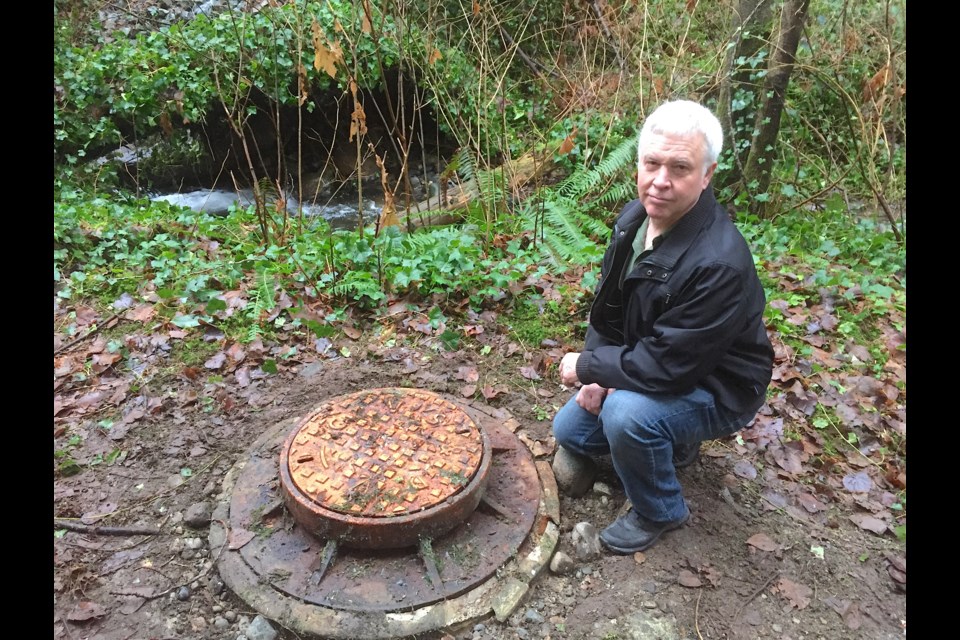A Coquitlam resident who lives in a home next to Stoney Creek fears he's witnessing an environmental disaster in the making.
Every time it rains heavily, Dave Irving explains water pours out of a sewer manhole cover behind his home, sending a wash of sewer water — and even bits of paper — into the fish-bearing tributary behind his house.
"If it ever comes off [the manhole cover], it's going to destroy this creek," he says.
Irving lives on Gilroy Crescent, close to North Road in Coquitlam and near the border of both Burnaby and Port Moody.
He fears development in his neighbourhood close to SkyTrain is contributing to the problem and if it's not slowed down, sewers over full with waste water will back up all over the region from Coquitlam through Burnaby and beyond.
"It's going to put more pressure on the already taxed system," said Irving.
But what if new development wasn't to blame?
What if it was his neighbours' old clay pipes and those of thousands of older homes in Port Moody, Coquitlam and Burnaby that are drawing in rainwater and sending it crashing through Metro Vancouver's sewer line to erupt in geysers of water into streets and creeks?
Metro Vancouver and Coquitlam officials say development, with PVC pipes meeting modern-day standards, is not the problem, but rather, inflow (rain water seeping into broken pipes) and infiltration (ground water penetrating into cracked or broken clay or concrete pipes) is causing the sewer over flows.
"It’s not development that’s driving it, it’s climate change — these atmospheric rivers have been causing overflows in these last two rainstorms," said Metro Vancouver's Peter Navratil, general manager of liquid waste services.
A LOT OF RAIN WATER
Officials say rainwater pulsing through the sewer system is five to 10 times the sewage volume — the equivalent of 20,000 homes flushing their toilets.
"This can be a common issue across the Lower Mainland, especially in older neighbourhoods like Stoney Creek," explained Jonathan Helmus, Coquitlam's director of utilities.
According to Helmus and Metro's Navratil, much of the excess fluid in the sewer system during heavy rains comes from poorly maintained residential storm and sewer systems.
The fact that sewer overflows don't happen in a dry summer is an indication that it's rain water getting in the sewer system that is to blame, they say.
So far, five homes in Coquitlam have been identified as having cross-connections between rainwater leaders and sewer systems, and all are co-operating to fix the problem.
More have to be found, said Helmus: "We need property owners to do their part."
In Nanaimo, the city has put out information to homeowners about the problem; Helmus agrees more needs to be done to impress on people the importance of maintaining their residential sewer and storm drain systems.
TRACKING POLLUTION
Something that may have been ignored in the past is now a crucial issue during climate change because what used to be rare rain events are now happening with disturbing regularity.
Burnaby and Port Moody are also working on the inflow and infiltration problem and are working with Metro Vancouver on a long-term plan that will also include replacing the Metro Vancouver trunk line.
"We're doing everything we can to find out where any of these issues are," said Helmus.
Coquitlam has also started upgrading local sanitary sewers in advance of increased development, aligned with the Servicing Assessment for this neighbourhood, and has a budget to find and fix holes in its own pipes.
It has also partnered with Burnaby to purchase water quality monitors to determine how much sewage is impacting local creeks.
Costs and timing to replace the aging Metro Vancouver sewer have not yet been determined.
However, Navratil said the project is being fast-tracked to handle increased capacity plus an allowance for rain water surges during atmospheric river events.
But for Irving, who is the president of the Oakdale Neighbourhood Association, the ongoing problem needs to be dealt with sooner rather than later and he's skeptical that the sewer overflows into Stoney Creek are merely caused by rain.
"I'm sure it's contributing to it," said Irving, "but it's also a capacity problem."





